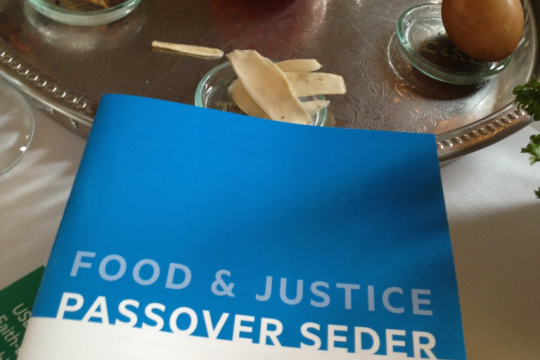
This year has marked several transitions for Temple Beth Avodah in Newton, MA. Our suburban, 430-household congregation had a major building and renovation project and a number of staff transitions. We looked to the Union for Reform Judaism for help recalibrating and to gain an understanding of our areas of strength and opportunities for growth.
The URJ Congregational Benchmarking and Assessment Project did just that. Consisting of three evaluative tools – a congregant survey, a financial and operating tool, and a board-self assessment rubric – this project is designed to give congregations the opportunity to take an inward look in a way that is consistent with other congregations. We participated in all three tools, and we were assigned a mentor who helped us understand all of the data (and there was a lot!) and set goals accordingly.
We were thrilled with our data, particularly with the results from our congregant survey in which 45 percent of our congregation participated. The average response rate for URJ congregations is 50 percent, so we were happy to come close that.
Like all synagogue staff and lay leaders, we work hard, and felt reaffirmed by congregants’ positive responses in the survey. Working long hours? Worth it because most survey respondents feel welcomed by our professional staff. Board leadership prioritizing attending events, talking to congregants, and generally being available? Check! According the survey results, the vast majority feel that our lay leadership represents their interests.
Learning all of this went a long way. It’s easy to get caught up in the momentum of synagogue life. With so much going on, it can be challenging to take time to reflect, so participating in this evaluative process fostered intentionality in our actions and priorities.
We’re blessed to have strong sacred partnerships among our staff and lay leadership, based upon shared respect, support, and appreciation. With this foundation, we’re gleaning lessons from our data that affirm our practices and challenge us to change and grow.
Here’s what we’ve learned from this process.
1. People want to be heard and feel valued.
A 45 percent response rate to the congregant survey was more than a good statistic – it was a first step to a congregational listening campaign. We’re aiming to further engage with our survey respondents, as well as with the 55 percent who didn’t complete the survey. Listening can happen in many ways; a survey is just one.
2. Our lay leadership is always looking to grow and improve our congregation.
As part of our results, we were able to compare between the board self-assessment rubric and the congregant survey for a handful of similar questions. For example, our board was asked, “Congregants know and understand the mission/vision/values of the synagogue,” while congregants were asked, “I know and understand the mission/vision/values of the synagogue.” The results of both questions were then put on a graph next to each other so we could see any discrepancies between the board’s perception and congregants’ perceptions.
We learned that leadership tended to view things in a more critical light, not because they are naysayers but because they are strong, invested, and always seeking for us to do better. We looked at the data at our board retreat and subsequently created topics for the board to tackle in the next year.
3. Intentionality makes a difference.
If you aren’t sure what you’re aiming for, you won’t know when you’re getting there. A few years, we wrote a clear vision statement, and our survey results demonstrated that our congregants know our vision and feel that it resonates with them. We’ve bought into a path together.
The same goes for our practices. There were areas in which we excelled because we have placed specific emphasis on them. For example, we prioritize our communications strategy and value creating a sense of belonging, and the data showed that we are strong in those areas. Conversely, the data shows that we have a great deal of opportunity for growth in our legacy giving programs, which we have known as we haven’t prioritized them recently.
This process isn’t straightforward, nor does it exist in isolation. We’ve not yet shared the results directly with the congregation (there is so much data), but the impact of these lessons is reverberating.
We’ve also enjoyed engaging with other URJ congregations who participated in this project. In November, we had the privilege of leading a webinar, part of a series for congregations participating in the URJ Congregational Benchmarking and Assessment Project. Each webinar is led by a congregation whose data showed a certain area of strength; ours, led by Eileen Brooks, our director of marketing and communications, focused on our strong communications tools and strategy.
It was an honor to share with other congregations our guiding principles and the creative practices that invigorate us and our community – and already, congregations have taken to the URJ Benchmarking and Assessment Tent group to share actionable steps that they’ve taken as a result of the webinar.
As a part of the URJ, we are blessed with a broad network with which to share our challenges and our accomplishments, to support each other when we are struggling, and to cheer each other on when we are successful. Participating in the URJ Congregational Benchmarking and Assessment Project means your synagogue becomes part of a group that, like you, values being reflective, celebrates a job well done alongside you, and provides the opportunity to grow and improve.
Learn more about the URJ Congregational Benchmarking and Assessment Project, which gives congregations the opportunity to take an inward look in a way that is consistent with other congregations, provides a basis for comparison with congregations of similar demographics, and empowers them to act upon the data with the URJ as their partner. Congregational leadership teams that participate by June 29, 2020, will receive their data by August 17, 2020.
Becky Oliver has been a staff member of Temple Beth Avodah in Newton, MA, for the past 15 years, serving in various roles. She recently became the temple director and has the privilege of leading the synagogue community with Rabbi Keith Stern and Temple President Stacy Schwartz.
Related Posts

Passover 2024: The Three Central Messages of Pesach

Modern-Day Plagues of Injustice and Inequality
